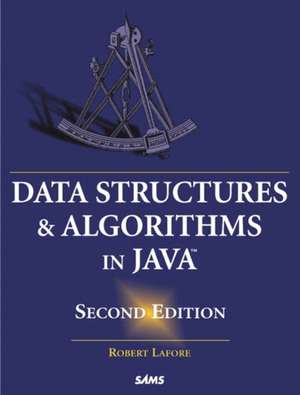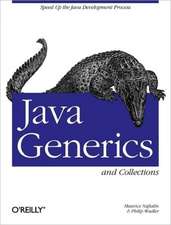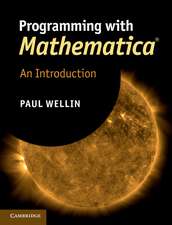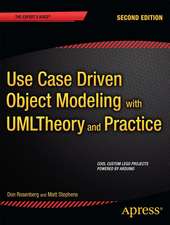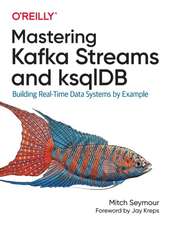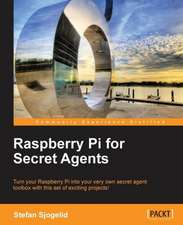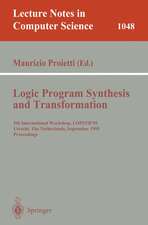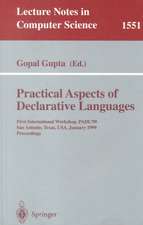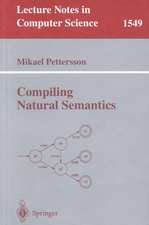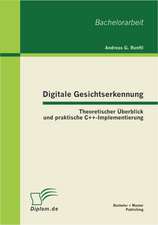Data Structures and Algorithms in Java
Autor Robert Laforeen Limba Engleză Hardback – 5 noi 2002
Appropriate for all courses in data structures and algorithms, and for many intermediate-to-advanced level courses in Java programming.
Many students view data structures and algorithms as difficult to understand, but this book thoroughly demystifies them. Working in Java, Robert Lafore presents each essential data structure and algorithm, using clear and simple example programs accessible through a Web browser-based "Workshop Applets." These programs demonstrate graphically exactly what each data structure looks like and how it works. Coverage includes: arrays, stacks, queues, simple and advanced sorts, linked lists, recursion, binary trees, red-black trees, 2-3-4 trees, external storage, hash tables, heaps, weighted graphs, and more. For this Second Edition, Lafore has rewritten each program to improve its operation, clarify the algorithms it illustrates, and reflect the latest versions of the Java 2 SDK. Lafore has also added brand-new questions and exercises at the end of every chapter. The result: students gain deep mastery over today's best practices and approaches for manipulating virtually any form of data with Java.
Preț: 366.33 lei
Preț vechi: 457.92 lei
-20% Nou
70.11€ • 72.92$ • 57.88£
Carte disponibilă
Livrare economică 25 martie-08 aprilie
Specificații
ISBN-10: 0672324539
Pagini: 800
Ilustrații: illustrations
Dimensiuni: 198 x 231 x 51 mm
Greutate: 1.48 kg
Ediția:Nouă
Editura: Sams Publishing
Locul publicării:Indianapolis, United States
Descriere
Educational Supplement
Suggested solutions to the programming projects found at the end of each chapter are made available to instructors at recognized educational institutions. This educational supplement can be found at www.prenhall.com, in the Instructor Resource Center.
Cuprins
Introduction.
What's New in the Second Edition. What This Book Is About. What's Different About This Book. Who This Book Is For. What You Need to Know Before You Read This Book. The Software You Need to Use This Book. How This Book Is Organized. Enjoy Yourself!
1. Overview.
What Are Data Structures and Algorithms Good For? Overview of Data Structures. Overview of Algorithms. Some Definitions. Object-Oriented Programming. Software Engineering. Java for C++ Programmers. Java Library Data Structures. Summary. Questions.
2. Arrays.
The Array Workshop Applet. The Basics of Arrays in Java. Dividing a Program into Classes. Class Interfaces. The Ordered Workshop Applet. Java Code for an Ordered Array. Logarithms. Storing Objects. Big O Notation. Whay Not Use Arrays for Everything. Summary. Questions. Experiments. Programming Projects.
3. Simple Sorting.
How Would You Do It. Bubble Sort. Selection Sort. Insertion Sort. Sorting Objects. Comparing the Simple Sorts. Summary. Questions. Experiments. Programming Projects.
4. Stacks and Queues.
A Different Kind of Structure. Stacks. Queues. Priority Queues. Parsing Arithmetic Expressions. Summary. Questions. Experiments. Programming Projects.
5. Linked Lists.
Links. The LinkList Workshop Applet. A Simple Linked List. Finding and Deleting Specified Links. Double-Ended Lists. Linked-List Efficiency. Abstract Data Types. Sorted Lists. Doubly Linked Lists. Iterators. Summary. Questions. Experiments. Programming Projects.
6. Recursion.
Triangular Numbers. Factorials. Anagrams. A Recursive Binary Search. The Towers of Hanoi. Mergesort. Eliminating Recursion. Some Interesting Recursive Applications. Summary. Questions. Experiments. Programming Projects.
7. Advanced Sorting.
Shellsort. Paartitioning. Quicksort. Radix Sort. Summary. Questions. Experiments. Programming Projects.
8. Binary Trees.
Why Use Binary Trees? Tree Terminology. An Analogy. How Do Binary Search Trees Work. Finding a Node. Inserting a Node. Traversing the Tree. Finding Maximum and Minimum Values. Deleting a Node. The Efficiency of Binary Trees. Trees Represented as Arrays. Duplicate Keys. The Complete tree.java Program. The Huffman Code. Summary. Questions. Experiments. Programming Projects.
9. Red-Black Trees.
Our Approach to the Discussion. Balanced and Unbalanced Trees. Using the RBTree Workshop Applet. Experimenting with the Workshop Applet. Rotations. Inserting a New Node. Deletion. The Efficiency of Red-Black Trees. Red-Black Tree Implementation. Other Balanced Trees. Summary. Questions. Experiments.
10. 2-3-4 Trees and External Storage.
Introduction to 2-3-4 Trees. The Tree234 Workshop Applet. Java Code for a 2-3-4 Tree. 2-3-4 Trees and Red-Black Trees. Efficiency of 2-3-4 Trees. 2-3 Trees. External Storage. Summary. Questions. Experiments. Programming Projects.
11. Hash Tables.
Introduction to Hashing. Open Addressing. Separate Chaining. Hash Functions. Hashing Efficiency. Hashing and External Storage. Summary. Questions. Experiments. Programming Projects.
12. Heaps.
Introduction to Heaps. The Heap Workshop Applet. Java Code fo Heaps. A Tree-based Heap. Heapsort. Summary. Questions. Experiments. Programming Projects.
13. Graphs.
Introduction to Graphs. Searches. Minimum Spanning Trees. Topological Sorting with Directed Graphs. Connectivity in Directed Graphs. Summary. Questions. Experiments. Programming Projects.
14. Weighted Graphs.
Minimum Spanning Tree with Weighted Graphs. The Shortest-Path Problem. The All-Pairs Shortest-Path Problem. Efficiency. Intractable Problems. Summary. Questions. Experiments. Programming Projects.
15. When to Use What.
General-Purpose Data Structures. Special-Purpose Data Structures. Sorting. Graphs. External Storage. Onward.
Appendix A. Running the Workshop Applets and Example Programs.
The Workshop Applets. The Example Programs. The Sun Microsystem's Software Development Kit. Multiple Class Files. Other Development Systems.
Appendix B. Further Reading.
Data Structures and Algorithms. Object-Oriented Programming Languages. Object-Oriented Design (OOD) and Software Engineering.
Appendix C. Answers to Questions.
Chapter 1, Overview. Chapter 2, Arrays. Chapter 3, Simple Sorting. Chapter 4, Stacks and Queues. Chapter 5, Linked Lists. Chapter 6, Recursion. Chapter 7, Advanced Sorting. Chapter 8, Binary Trees. Chapter 9, Red-Black Trees. Chapter 10, 2-3-4 Trees and External Storage. Hash Tables. Heaps. Graphs. Weighted Graphs.
Index.
Notă biografică
Caracteristici
- NEW - Fully updated to improve clarity and performance, and reflect Sun's latest Java 2 platform releases.
- Presents state-of-the-art techniques students can rely upon for many years to come.
- Presents state-of-the-art techniques students can rely upon for many years to come.
- NEW - New questions and exercises at the end of every chapter.
- Helps students review the material and confirm that they understand it in detail.
- Helps students review the material and confirm that they understand it in detail.
- Simple, thorough, example rich coverage of Java data structures and algorithms—Covers arrays, stacks, queues, sorts, linked lists, recursion, binary trees, red-black trees, 2-3-4 trees, external storage, hash tables, heaps, weighted graphs, and more.
- Illuminates all the algorithms and data structures students will need to manipulate any kind of data with Java.
- Illuminates all the algorithms and data structures students will need to manipulate any kind of data with Java.
- Browser-based “Workshop Applet” tool visualizes algorithms and data structures—Simple browser-based software shows students how data structures and algorithms look and work.
- Brings algorithms and data structures to life, making them easier than ever for students to understand.
- Brings algorithms and data structures to life, making them easier than ever for students to understand.
Caracteristici noi
- Fully updated to improve clarity and performance, and reflect Sun's latest Java 2 platform releases.
- Presents state-of-the-art techniques students can rely upon for many years to come.
- Presents state-of-the-art techniques students can rely upon for many years to come.
- New questions and exercises at the end of every chapter.
- Helps students review the material and confirm that they understand it in detail.
- Helps students review the material and confirm that they understand it in detail.
